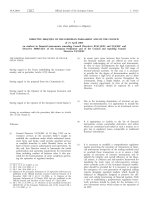COMMUNICATION FROM THE COMMISSION TO THE EUROPEAN PARLIAMENT AND THE COUNCIL docx
Bạn đang xem bản rút gọn của tài liệu. Xem và tải ngay bản đầy đủ của tài liệu tại đây (157.7 KB, 10 trang )
EN EN
EUROPEAN COMMISSION
Brussels, 12.9.2012
COM(2012) 510 final
COMMUNICATION FROM THE COMMISSION TO THE EUROPEAN
PARLIAMENT AND THE COUNCIL
A Roadmap towards a Banking Union
2
COMMUNICATION FROM THE COMMISSION TO THE EUROPEAN
PARLIAMENT AND THE COUNCIL
A Roadmap towards a Banking Union
3
1. INTRODUCTION
Over the past four years, the EU has responded decisively to the economic and financial
crisis. Significant improvements have been made to the Economic and Monetary Union
(EMU), and a substantial financial reform agenda is being implemented, fulfilling
commitments made in the G20 in response to the financial crisis, and to make financial
institutions and markets more stable, more competitive and more resilient
1
.
Completing this reform of the EU regulatory framework is essential but will not be sufficient
to successfully address significant threats to financial stability across the Economic and
Monetary Union. Further steps are needed to tackle the specific risks within the Euro Area,
where pooled monetary responsibilities have spurred close economic and financial integration
and increased the possibility of cross-border spill-over effects in the event of bank crises, and
to break the link between sovereign debt and bank debt and the vicious circle which has led to
over €4,5 trillion of taxpayers money being used to rescue banks in the EU. Coordination
between supervisors is vital but the crisis has shown that mere coordination is not enough, in
particular in the context of a single currency and that there is a need for common decision-
making. It is also important to curtail the increasing risk of fragmentation of EU banking
markets, which significantly undermines the single market for financial services and impairs
the effective transmission of monetary policy to the real economy throughout the Euro Area.
The Commission has therefore called
2
for a banking union to place the banking sector on a
more sound footing and restore confidence in the Euro as part of a longer term vision for
economic and fiscal integration. Shifting the supervision of banks to the European level is a
key part of this process, which must subsequently be combined with other steps such as a
common system for deposit protection, and integrated bank crisis management. The report by
the Presidents of the European Council, the Commission, the Eurogroup and the European
Central Bank (ECB) of 26 June 2012
3
endorsed this vision. For its part, the European
Parliament has recommended steps in the same direction, for example in its report from July
2010 on cross-border crisis management in the banking sector
4
. This was also confirmed by
the Euro Area Summit of 29 June 2012
5
.
Ensuring that bank supervision and resolution across the Euro Area meets high standards will
reassure citizens and markets that a common, high level of prudential regulation is
1
2
3
4
European Parliament resolution of 7 July 2010 with recommendations to the Commission on Cross-Border
Crisis Management in the Banking Sector (2010/2006(INI))
5
"The Commission will present Proposals on the basis of Article 127(6) for a single supervisory mechanism
shortly. We ask the Council to consider these Proposals as a matter of urgency by the end of 2012.
When an effective single supervisory mechanism is established, involving the ECB, for banks in the
euro area the ESM could, following a regular decision, have the possibility to recapitalize banks
directly. This would rely on appropriate conditionality, including compliance with state aid rules, which
should be institution specific, sector-specific or economy-wide and would be formalised in a
Memorandum of Understanding".
/>
4
consistently applied to all banks. If banks get into difficulties in the future, the public should
have the confidence that ailing banks will be restructured or closed while minimizing costs for
the taxpayer. This future system will help build the necessary trust between Member States,
which is a pre-condition for the introduction of any common financial arrangements to protect
depositors and support orderly resolution of failing banks.
This communication accompanies two legislative proposals, respectively for the setting up of
a single supervisory mechanism by conferring specific tasks on the ECB concerning policies
relating to the prudential supervision of credit institutions and for adaptations to the
Regulation setting up the European Banking Authority (EBA)
6
. These legislative proposals
mark a first important step which will make a qualitative improvement in financial stability
and confidence in the Euro Area in particular. This communication sets the single supervisory
mechanism in context and indicates further work towards a banking union beyond these first
proposals.
2. THE BANKING UNION AND THE SINGLE MARKET
The single market for financial services is based on common rules which ensure that banks
and other financial institutions which under the Treaty enjoy rights of free establishment and
free provision of services are subject to equivalent rules and proper supervision across the EU.
The creation of the banking union must not compromise the unity and integrity of the single
market which remains one of the greatest achievements of European integration. Indeed, the
banking union rests on the completion of the programme of substantive regulatory reform
underway for the single market (the "single rulebook").
The single market and the banking union are thus mutually reinforcing processes. Work to
strengthen the single market must continue across all existing areas covered by Commission
proposals.
Moreover, in three areas of specific relevance to the banking union, this work should be
accelerated and agreement between the co-legislators on the relevant proposals reached before
the end of 2012:
– Stronger prudential requirements for banks have been proposed. With its proposals
on bank capital requirements ("CRD4")
7
, the Commission launched the process of
implementing the new global standards on bank capital and liquidity. The creation of
the single supervisory mechanism should not require substantive changes to the
proposed regulation and directive, although in a limited number of areas, some fine-
tuning may be required to reflect the new situation. During the final stages of the
CRD4 negotiations, the Commission will pay particular attention to ensure that the
texts agreed are technically compatible with the proposed Regulation setting up the
single supervisory mechanism, and will work with the European Parliament and the
Council in this perspective. This will include in particular ensuring that all provisions
6
Regulation (EU) No 1093/2010
7
5
of the proposed CRD4 Directive are operational for application both at national level
and by the ECB.
– The coverage of national Deposit Guarantee Schemes (DGS) has already been raised
to a harmonised level of €100,000 per depositor, per institution, effective as of 31
December 2010. In July 2010, the Commission proposed
8
going further, with the
harmonisation and simplification of protected deposits, faster pay-outs and improved
financing, notably through the ex-ante funding of deposit guarantee schemes paid for
by contributions from banks and a mandatory borrowing facility between national
schemes within certain fixed limits.
– The Commission's proposal on recovery and resolution tools for banks in crisis,
adopted on 6 June 2012
9
, is the last in a series of proposed measures to strengthen
Europe's banking sector and to avoid the spill-over effects of any future financial
crisis with negative effects on depositors and taxpayers. To ensure that financial
stability is upheld while bank shareholders and creditors bear their full share of bank
losses and recapitalisation costs, the Commission has proposed a common
framework of rules and powers. This will help Member States prevent bank crises
from emerging in the first place and, if such bank crises still emerge, to manage them
in a more orderly and effective way. Member States would be required to establish
an ex-ante resolution fund paid for by contributions from banks, and provision is
made for a mandatory borrowing facility between national schemes, again subject to
clear limits.
These rules will therefore constitute a common foundation across the single market on which
the banking union proposals can build. This single rulebook is needed for the stability and
integrity of the EU's internal market in financial services. It provides a common foundation
which allows a move to the banking union without any risk of fragmenting the single market.
Swift delivery of the outstanding reforms on capital requirements, deposit guarantee schemes,
and bank resolution by the co-legislators by the end of the year, is therefore paramount.
These rules also have to be applied in the same way across the whole Union, through coherent
and convergent supervision of credit institutions by national supervisors and the ECB. The
European Banking Authority (EBA) has a crucial role in delivering this objective, in
particular, by the set of instruments and powers provided by its founding regulation
(addressing breaches of Union law, mediation, binding technical standards, guidelines, and
recommendations). It is therefore critical that the EBA plays fully its role to build a common
legal framework and supervisory culture across the whole Union.
Moreover, in order to avoid any divergence between the Euro Area and the rest of the EU, the
single rulebook should be underpinned by uniform supervisory practices. Different
supervisory handbooks and supervisory approaches between the Member States participating
in the single supervisory mechanism and the other Member States pose a risk of
fragmentation of the single market, as banks could exploit the differences to pursue regulatory
arbitrage. The EBA should develop a single supervisory handbook to complement the single
rulebook.
8
9
6
Any measures adopted by the ECB – for example to spell out further details on how
prudential supervision is carried out in the context of the specific supervisory structure created
by the single supervisory mechanism – must be in line with the single rulebook including the
technical standards set out by delegated acts adopted by the European Commission. Finally, it
should be noted that today's proposal maintains the current balance between home and host
Member States, including as regards participation in supervisory colleges.
The effective impact and implications of the single supervisory mechanism on the operational
functioning of the EBA will be further examined in the forthcoming review on the functioning
of the European Supervisory Authorities to be presented by the Commission by 2 January
2014
10
. In that context, the Commission will in particular examine whether the role of the
EBA with regard to stress testing exercises needs to be strengthened, to avoid making the
authority too dependent on information and contributions by those authorities competent for
assessing the effective resilience of the banking sector across the Union.
In parallel, the Commission will continue to strengthen financial stability and ensure a level
playing field in the EU single market for banking through its control of state aid and
conditionality for economic adjustment aid.
Key actions
The Commission calls on the European Parliament and the Council to reach agreement by
end-2012 on:
(i) the CRD4 proposals, making them applicable both across the single market and within the
context of the single supervisory mechanism;
(ii) the proposal for a Directive on Deposit Guarantee Schemes as proposed by the
Commission;
(iii) the proposal for a Directive on bank recovery and resolution.
3. COMPLETING THE BANKING UNION
As set out by the Commission
11
before the June 2012 European Council and in the report of
the Presidents of the European Council, the Commission, the Eurogroup and the European
Central Bank of 26 June 2012
12
, completing the banking union will require further work to
deliver a single supervisory mechanism, a common system for deposit guarantees and an
integrated crisis management framework. The establishment of the single supervisory
mechanism is a crucial and significant first step.
10
Pursuant to Article 81 of the Regulations establishing the European Supervisory Authorities [Regulation (EU)
No 1093/2010, Regulation (EU) No 1094/2010, and Regulation (EU) No 1095/2010]
11
12
7
3.1. A Single Supervisory Mechanism
The single supervisory mechanism which the Commission is proposing today is based on the
transfer to the European level of specific, key supervisory tasks for banks established in the
Euro Area Member States. While retaining ultimate responsibility, the ECB would carry out
its tasks within the single supervisory mechanism composed of the ECB and national
supervisory authorities. This structure will provide strong and consistent supervision across
the Euro Area, while making best use of the local and specific know-how of national
supervisors. This will ensure that supervision remains highly aware of all national and local
conditions relevant for financial stability. The Commission also proposes a mechanism which
will allow Member States which have not adopted the Euro, but would like to participate in
the single supervisory mechanism, to cooperate closely with the ECB.
Under the single supervisory mechanism, the ECB will become responsible for supervising all
banks within the banking union, to which it will apply the single rulebook applicable across
the single market. Recent experience has shown that difficulties, even in relatively small
banks, can have significant negative impacts on the financial stability of Member States.
Therefore, from the first day, the ECB will be empowered to take over the supervision of any
bank in the Euro Area if it so decides, in particular if the bank is receiving public support. For
all other banks, ECB supervision will be phased in automatically: on 1 July 2013 for the most
significant European systemically important banks, and on 1 January 2014 for all other banks.
Therefore, by 1 January 2014 all banks in the Euro Area will come under European
supervision.
The ECB will be granted key specific supervisory tasks which are indispensable to ensure
detection of risks threatening the viability of banks. It will be empowered to require banks to
take the necessary remedial action. The ECB will, inter alia, be the competent authority for
authorizing credit institutions, assessing qualifying holdings, ensuring compliance with the
minimum capital requirements, ensuring the adequacy of internal capital in relation to the risk
profile of a credit institution ("Pillar 2 measures"), conducting supervision on a consolidated
basis and supervisory tasks in relation to financial conglomerates. The ECB will also ensure
compliance with provisions on leverage and liquidity, apply capital buffers and carry out, in
coordination with resolution authorities, early intervention measures when a bank is in breach
of, or is about to breach, regulatory capital requirements.
The ECB will be vested with the necessary investigatory and supervisory powers to perform
its tasks. Active involvement of national supervisors within the SSM is provided for to ensure
the smooth and efficient preparation and implementation of supervisory decisions as well as
the necessary coordination and information flow regarding issues of both local and European
reach, in order to ensure financial stability across the Union and its Member States.
All tasks not explicitly conferred upon the ECB will remain with national supervisors. For
example, national supervisors will remain in charge of consumer protection and the fight
against money laundering, and of the supervision of third country credit institutions
establishing branches or providing cross-border services within a Member State.
8
The ECB must be able to carry out its new supervisory functions in full independence whilst
being fully accountable for its actions. The Commission proposal contains strong
accountability safeguards, notably vis-à-vis the European Parliament and the Council, to
ensure democratic legitimacy. In addition, the proposal lays down a number of organisational
principles to ensure clear separation between monetary policy and supervision. This will
mitigate potential conflicts between different policy objectives, while at the same time
allowing full advantage to be taken of synergies. All preparatory activities and policy
execution will therefore be carried out by bodies and administrative divisions separate from
monetary policy functions through a supervisory board established within the ECB for this
express purpose.
Finally, the proposed amendments of the EBA Regulation will ensure that the EBA can
continue to fulfil its mission effectively as regards all Member States. In particular, EBA will
exercise its powers and tasks also vis-à-vis the ECB. Voting arrangements within the EBA
will be adapted to ensure EBA decision-making structures continue to be balanced and
effective reflecting the positions of the competent authorities of Member States participating
in the single supervisory mechanism and those which do not, and thereby preserving fully the
integrity of the single market. Amendments of voting arrangements have been targeted to
those areas where the EBA takes binding decisions on the application of the single rulebook
when pursuing breaches of law and settling disagreements. In other areas, existing procedural
safeguards are considered sufficient to ensure balanced and effective decisions making in
those areas. For example, draft technical standards are submitted to the Commission for
adoption, and the Commission can decide not to endorse or to modify them, in particular
when they are not in full conformity with the fundamental principles of the internal market for
financial services. Finally, a targeted review clause has been inserted in the draft Regulation
amending Regulation 1093/2010 so as to take into account in particular any developments in
the number of Member States whose currency is the Euro or whose competent authorities
have entered into a close cooperation and examine whether in light of such developments any
further adjustments of those provisions are necessary to ensure that EBA decisions are taken
in the interest of maintaining and strengthening the internal market for financial services.
Key Actions
The Commission calls:
(i) on the Council to consider and adopt urgently the proposal for a Council Regulation
conferring specific tasks on the ECB concerning policies relating to the prudential
supervision of credit institutions taking into account the opinion of the European Parliament;
(ii) on the European Parliament and the Council to consider and adopt urgently the proposal
amending Regulation 1093/2010 establishing the EBA.
Agreement on these two proposals should be reached before the end of 2012.
9
3.2. Next Steps in the Management of Bank Crises
Global financial integration and the EU single market have enabled the banking sector in
some Member States to outgrow national GDP many times over, resulting in institutions
which are "too-big-to-fail" and "too-big-to-save" under existing national arrangements. On the
other hand, experience shows that the failure of even relatively small banks may cause cross-
border systemic damage. Furthermore, bank runs across borders can critically weaken
national banking systems, further damaging the fiscal standing of the sovereign, and hastening
funding problems for both.
Reinforced supervision within the banking union will help improve the robustness of banks. If
a crisis nonetheless occurs it is necessary to ensure that institutions can be resolved in an
orderly manner and that depositors are assured their savings are safe.
Against this background, the Commission has underlined
13
that a banking union should
include a more centralised management of banking crises. The European Parliament has also
called for progress in this area. The need for "common mechanisms to resolve banks and
guarantee customer deposits" was also referred to in the report by the Presidents of the
European Council, the Commission, the Eurogroup and the European Central Bank of 26 June
2012
14
.
Therefore, the Commission envisages notably making a proposal for a single resolution
mechanism which would govern the resolution of banks and coordinate in particular the
application of resolution tools to banks within the banking union. This mechanism would be
more efficient than a network of national resolution authorities, in particular in the case of
cross-border failures, given the need for speed and credibility in addressing banking crises. It
would be a natural complement to the establishment of a single supervisory mechanism. It
would also entail significant economies of scale, and avoid the negative externalities that may
derive from purely national decisions. It would take its decisions in line with the principles of
resolution set out in the single rulebook which are consistent with international best practice
and in full compliance with Union state aid rules. In particular shareholders and creditors
should bear the costs of resolution before any external funding is granted, and private sector
solutions should be found instead of using taxpayers' money.
Moreover, and based on an assessment of its functioning, such a single resolution mechanism
could also be entrusted with further tasks of coordination regarding the management of crisis
situations and resolution tools in the banking sector, as set out in the report presented in June
2012 by the Presidents of the European Council, the Commission, the ECB and the
Eurogroup.
13
14
10
Key actions
Once agreement on the existing DGS and Bank Recovery and Resolution proposals is
achieved, the Commission envisages to propose notably a single resolution mechanism to
resolve banks and to coordinate the application of resolution tools to banks under the banking
union.
4. NEXT STEPS
The European Union has the means to address its current weaknesses and set up the banking
union as an essential step towards a genuine Economic and Monetary Union.
The Commission calls on the European Parliament and the Council to:
– give their full support to the banking union and endorse the orientations and roadmap
described in this Communication;
– give the highest priority in the legislative process to the actions necessary for
establishing the banking union;
– finalise, as soon as possible and in any case before the end of the year, the proposals
on the table on:
– Deposit Guarantee Schemes;
– access to the activity of credit institutions and the prudential supervision of
credit institutions and investment firms (CRD);
– prudential requirements for credit institutions and investment firms (CRR);
– a framework for the recovery and resolution of credit institutions and
investment firms;
– conferring certain tasks on the ECB relating to the prudential supervision of
credit institutions;
– amending certain provisions of the EBA Regulation.
With this communication and the accompanying legislative proposals, the Commission has
acted swiftly and responsibly in response to the mandate given by the European Council and
the Heads of State and Government of the Euro area at the end of June. Other institutions now
need to do their part to ensure the single supervisory mechanism is established by 1 January
2013.









